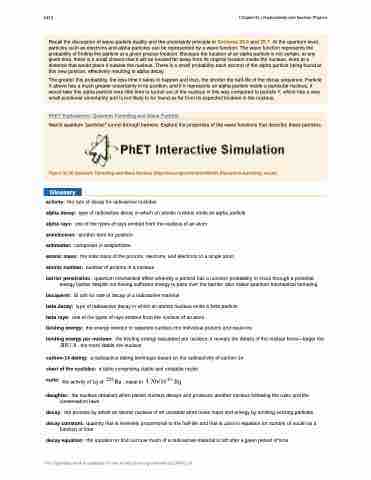Page 1436 - College Physics For AP Courses
P. 1436
1424 Chapter 31 | Radioactivity and Nuclear Physics
Recall the discussion of wave-particle duality and the uncertainty principle in Sections 29.6 and 29.7. At the quantum level, particles such as electrons and alpha particles can be represented by a wave function. The wave function represents the probability of finding the particle at a given precise location. Because the location of an alpha particle is not certain, at any given time, there is a small chance that it will be located far away from its original location inside the nucleus, even at a distance that would place it outside the nucleus. There is a small probability each second of the alpha particle being found at this new position, effectively resulting in alpha decay.
The greater this probability, the less time it takes to happen and thus, the shorter the half-life of the decay sequence. Particle X above has a much greater uncertainty in its position, and if it represents an alpha particle inside a particular nucleus, it would take this alpha particle very little time to tunnel out of the nucleus in this way compared to particle Y, which has a very small positional uncertainty and is not likely to be found as far from its expected location in the nucleus.
PhET Explorations: Quantum Tunneling and Wave Packets
Watch quantum "particles" tunnel through barriers. Explore the properties of the wave functions that describe these particles.
Figure 31.35 Quantum Tunneling and Wave Packets (http://cnx.org/content/m54934/1.2/quantum-tunneling_en.jar)
Glossary
activity: the rate of decay for radioactive nuclides
alpha decay: type of radioactive decay in which an atomic nucleus emits an alpha particle
alpha rays: one of the types of rays emitted from the nucleus of an atom
antielectron: another term for positron
antimatter: composed of antiparticles
atomic mass: the total mass of the protons, neutrons, and electrons in a single atom
atomic number: number of protons in a nucleus
barrier penetration: quantum mechanical effect whereby a particle has a nonzero probability to cross through a potential energy barrier despite not having sufficient energy to pass over the barrier; also called quantum mechanical tunneling
becquerel: SI unit for rate of decay of a radioactive material
beta decay: type of radioactive decay in which an atomic nucleus emits a beta particle
beta rays: one of the types of rays emitted from the nucleus of an atom
binding energy: the energy needed to separate nucleus into individual protons and neutrons
binding energy per nucleon: the binding energy calculated per nucleon; it reveals the details of the nuclear force—larger the �� � � , the more stable the nucleus
carbon-14 dating: a radioactive dating technique based on the radioactivity of carbon-14 chart of the nuclides: a table comprising stable and unstable nuclei
curie: the activity of 1g of ��� �� , equal to ��������� ��
daughter: the nucleus obtained when parent nucleus decays and produces another nucleus following the rules and the
conservation laws
decay: the process by which an atomic nucleus of an unstable atom loses mass and energy by emitting ionizing particles
decay constant: quantity that is inversely proportional to the half-life and that is used in equation for number of nuclei as a function of time
decay equation: the equation to find out how much of a radioactive material is left after a given period of time
This OpenStax book is available for free at http://cnx.org/content/col11844/1.14


